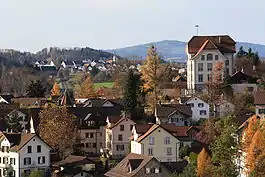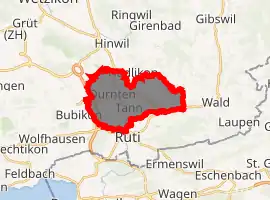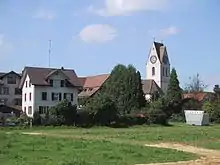Dürnten
Dürnten is a municipality in the district of Hinwil in the canton of Zürich in Switzerland.
Dürnten | |
|---|---|
 | |
 Coat of arms | |
Location of Dürnten 
| |
 Dürnten  Dürnten | |
| Coordinates: 47°17′N 8°51′E | |
| Country | Switzerland |
| Canton | Zürich |
| District | Hinwil |
| Area | |
| • Total | 10.22 km2 (3.95 sq mi) |
| Elevation | 511 m (1,677 ft) |
| Population (2018-12-31)[2] | |
| • Total | 7,636 |
| • Density | 750/km2 (1,900/sq mi) |
| Time zone | UTC+01:00 (Central European Time) |
| • Summer (DST) | UTC+02:00 (Central European Summer Time) |
| Postal code(s) | 8635 |
| SFOS number | 0113 |
| Localities | Tann, Dürnten, Oberdürnten, Breitenmatt |
| Surrounded by | Bubikon, Hinwil, Rüti, Wald |
| Twin towns | Szentbékkálla (Hungary) |
| Website | www SFSO statistics |
History
Dürnten is first mentioned between 743 and 747 as Tunriude.[3]
Geography

Dürnten has an area of 10.2 km2 (3.9 sq mi). Of this area, 60.4% is used for agricultural purposes, while 17% is forested. Of the rest of the land, 21.4% is settled (buildings or roads) and the remainder (1.1%) is non-productive (rivers, glaciers or mountains).[4] In 1996 housing and buildings made up 13.9% of the total area, while transportation infrastructure made up the rest (7.4%).[5] Of the total unproductive area, water (streams and lakes) made up 0.8% of the area. As of 2007 15.4% of the total municipal area was undergoing some type of construction.[5]
The Jona river flows through the municipality. It is located in the south-west side of Bachtel mountain. It includes the villages of Dürnten, Oberdürnten and Tann.
Demographics
Dürnten has a population (as of 31 December 2019) of 7,606.[6] As of 2007, 14.9% of the population was made up of foreign nationals. As of 2008 the gender distribution of the population was 50.2% male and 49.8% female. Over the last 10 years the population has grown at a rate of 8%. Most of the population (as of 2000) speaks German (89.3%), with Albanian being second most common ( 2.6%) and Italian being third ( 2.5%).
In the 2007 election the most popular party was the SVP which received 41.3% of the vote. The next three most popular parties were the SPS (15%), the CSP (10.4%) and the FDP (10.1%).
The age distribution of the population (as of 2000) is children and teenagers (0–19 years old) make up 25.1% of the population, while adults (20–64 years old) make up 60.8% and seniors (over 64 years old) make up 14%. The entire Swiss population is generally well educated. In Dürnten about 76.7% of the population (between age 25-64) have completed either non-mandatory upper secondary education or additional higher education (either university or a Fachhochschule). There are 2464 households in Dürnten.[5]
Dürnten has an unemployment rate of 1.79%. As of 2005, there were 155 people employed in the primary economic sector and about 51 businesses involved in this sector. 268 people are employed in the secondary sector and there are 68 businesses in this sector. 847 people are employed in the tertiary sector, with 149 businesses in this sector.[4] As of 2007 39.4% of the working population were employed full-time, and 60.6% were employed part-time.[5]
As of 2008 there were 1803 Catholics and 2697 Protestants in Dürnten. In the 2000 census, religion was broken down into several smaller categories. From the 2000 census, 49.6% were some type of Protestant, with 44.3% belonging to the Swiss Reformed Church and 5.3% belonging to other Protestant churches. 28.7% of the population were Catholic. Of the rest of the population, 0% were Muslim, 7.9% belonged to another religion (not listed), 2.7% did not give a religion, and 10.8% were atheist or agnostic.[5] The Sri Vishnu Thurkkai Amman Temple in Dürnten was inaugurated in 2010.[7][8]
The historical population is given in the following table:[3]
| Demographics | |
|---|---|
| year | population |
| 1670 | 977 |
| 1792 | 1382 |
| 1850 | 1663 |
| 1900 | 3094 |
| 1941 | 3006 |
| 1950 | 3390 |
| 1990 | 5736 |
| 1995 | 5843 |
| 2000 | 6032 |
| 2005 | 6081 |
| 2010[9] | 6665 |
| 2011[9] | 7055 |
International relations
References
- "Arealstatistik Standard - Gemeinden nach 4 Hauptbereichen". Federal Statistical Office. Retrieved 13 January 2019.
- "Ständige Wohnbevölkerung nach Staatsangehörigkeitskategorie Geschlecht und Gemeinde; Provisorische Jahresergebnisse; 2018". Federal Statistical Office. 9 April 2019. Retrieved 11 April 2019.
- Dürnten in German, French and Italian in the online Historical Dictionary of Switzerland.
- Swiss Federal Statistical Office Archived January 5, 2016, at the Wayback Machine accessed 06-Aug-2009
- Statistics Zürich (in German) accessed 4 August 2009
- "Ständige und nichtständige Wohnbevölkerung nach institutionellen Gliederungen, Geburtsort und Staatsangehörigkeit". bfs.admin.ch (in German). Swiss Federal Statistical Office - STAT-TAB. 31 December 2019. Retrieved 6 October 2020.
- Regula Lienin (2013-07-20). "Ein Pfauentanz für Göttin Amman" (in German). Zürcher Oberländer. Retrieved 2014-12-18.
- Patrizia Legnini (2010-01-17). "Indische Handwerker bauen Hindu-Tempel – ohne Bewilligung" (in German). Limmattaler Zeitung. Retrieved 2014-12-18.
- http://www.duernten.ch/xml_1/internet/de/application/d4/f54.cfm; retrieved, 27 February 2012).
- "Partnergemeinde Szentbékkálla (HU)". 2014-02-08.
External links
| Wikimedia Commons has media related to Dürnten. |
- Official website (in German)
- Dürnten in German, French and Italian in the online Historical Dictionary of Switzerland.
